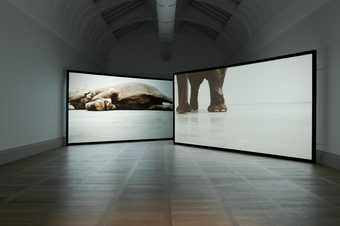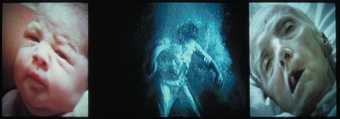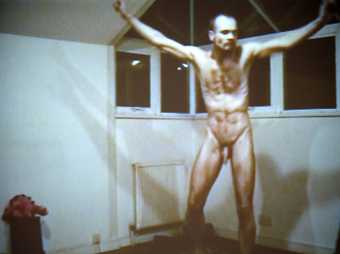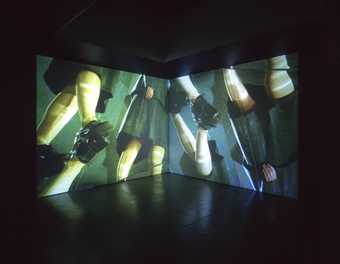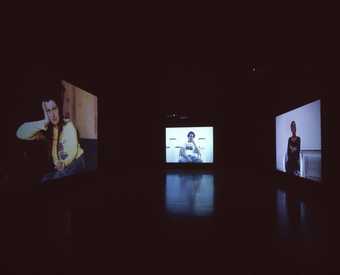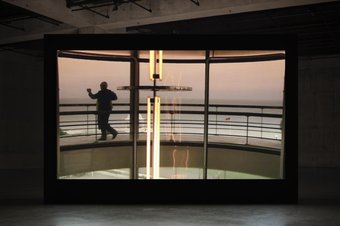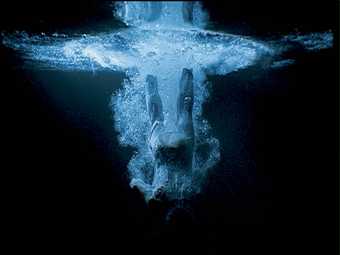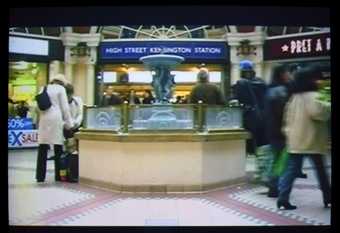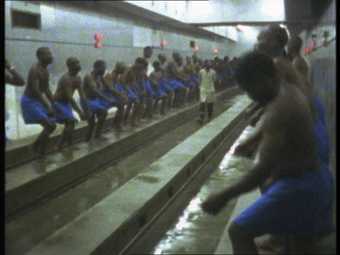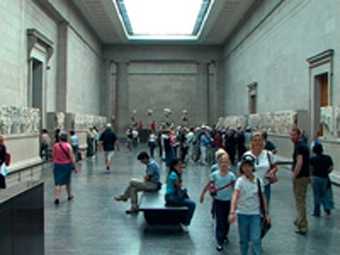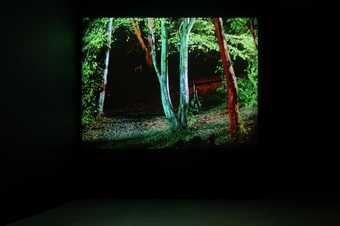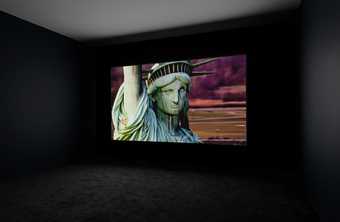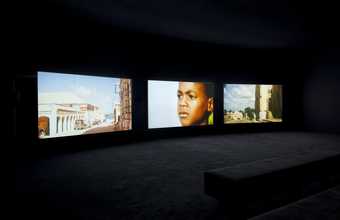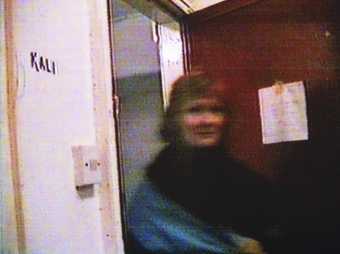
Not on display
- Artist
- Sir Isaac Julien CBE RA born 1960
- Medium
- Video, 2 back projections, colour and sound
- Dimensions
- Duration: 7 min
overall display dimensions variable - Collection
- Tate
- Acquisition
- Purchased with assistance from the American Patrons of Tate (Eileen-Harris Norton and the Peter Norton Family Foundation, Kathy and Richard S. Fuld Jr), Poju and Anita Zabludowicz 2004
- Reference
- T11943
Summary
Vagabondia 2000 is a seven-minute video by the British filmmaker and artist Isaac Julien. The work is set in the Sir John Soane’s Museum in London, the former residence of the British architect Sir John Soane (1753–1837), which he designed and built himself between 1792 and 1824 and in which his collection of art and artefacts is still housed. The video shows a black female curator–conservator as she inspects the museum at night. As she moves around, fantastical figures in period dress appear in the house. One of these assumes the character of Soane himself, who walks through the space surveying its contents and studying his reflection in a mirror, and two black women are shown sitting together, leafing through a book and talking. A black male dancer moves about in a room of the house that Soane designed especially for the series of paintings A Rake’s Progress 1732–3 by the British artist William Hogarth (1697–1764). Although these characters do not interact with the curator–conservator, clips of them are interspersed with images of her walking through the museum. As the curator–conservator explores the establishment, a voice-over speaking in Saint Lucian Creole French – a mixture of French, Carib and African languages – is played. At times the footage on the screen is split into two, with one side flipped horizontally so that the scene appears twice side by side in the style of a mirror image, and these split scenes frequently merge and collapse into one another in a kaleidoscopic manner. At other times, the footage one side of the screen is slowed down, so that its action is delayed when compared to that of its mirrored counterpart.
Julien filmed Vagabondia in the Sir John Soane’s Museum in 2000 and edited it in his studio in London. It was commissioned by the new media agency Film and Video Umbrella for the exhibition Retrace Your Steps: Remember Tomorrow that was held at the Sir John Soane’s Museum in the same year. The actress Cleo Sylvestre played the main role of the curator–conservator, and Julien collaborated with the Venezuelan choreographer Javier de Frutos to create the dance featured in the film, which was performed by the British contemporary dancer Ben Ash. The British composer Paul Gladstone Reid, whose work combines Western and African musical traditions, wrote an original soundtrack for Vagabondia, and Julien’s mother provided the Creole voice-over recording that the artist added to the footage during the editing process.
The work’s title, Vagabondia, is a reference to the dancer featured in the film who is based on the black vagabond that appears in A Rake’s Progress, Hogarth’s series of eight paintings showing the demise of Tom Rakewell, the son of a rich merchant. A Rake’s Progress is among the best-known set of objects in Soane’s collection, although the black beggar on which Julien focuses in Vagabondia is not usually discussed in guided tours of the museum. According to the art historians Bridget Elliot and Jennifer Kennedy, the figure of the vagabond is used by Julien to highlight the ways in which the museum’s collection has benefitted from the colonisation of other cultures:
Careening off the walls and dancing spasmodically in a bizarrely doubled body that melts and folds back into itself, the Trickster seems to belong to the uncanny space of Soane’s museum, becoming yet another exotic object, and to disrupt its peace and quiet, bringing unpredictable life into the mausoleum … As Trickster, the character’s ghostly presence conjures up the spectre of colonised subjects and their cultures, many of which Soane collected and objectified through the profits of Empire.
(Elliot and Kennedy 2006, accessed 28 December 2014.)
Moreover, Julien has spoken of how the Creole voice-over contributes to the film’s reflections on colonialism:
For centuries [Saint Lucia Creole has] been considered subordinate to metropolitan French yet for me it’s a kind of hybrid between French, African and Carib languages. It has an enormous possibility for trespassing … the Creole language has been very central … in terms of its relationship to slavery and sort of being able to utilise the language that the master wouldn’t understand.
(Julien 2014, accessed 12 March 2015.)
No translation or captions are offered alongside the Creole voice-over and as such those not familiar with the language will not be able to understand the words spoken by the film’s faceless commentator. In this way Vagabondia may be seen as an attempt to undermine the power carried by historical narratives in museums by countering the dominance of the English language in the interpretation and presentation of objects from non-European cultures.
Further reading
Turner Prize 2001, exhibition catalogue, Tate Britain, London 2001, pp.9–10.
Bridget Elliot and Jennifer Kennedy, ‘Haunting the Artist’s House: Sir John Soane’s Museum and Isaac Julien’s Vagabondia’, Image and Narrative, February 2006, http://www.imageandnarrative.be/inarchive/house_text_museum/elliott_kennedy.htm, accessed 28 December 2014.
Isaac Julien, ‘Isaac Julien: Vagabondia’, lecture, Tate Modern, London, 4 February 2014, http://www.tate.org.uk/context-comment/audio/isaac-julien-vagabondia, accessed 12 March 2015.
Michal Goldschmidt
March 2015
Supported by Christie’s.
Does this text contain inaccurate information or language that you feel we should improve or change? We would like to hear from you.
Film and audio
Explore
- emotions, concepts and ideas(16,416)
-
- formal qualities(12,454)
-
- photographic(4,673)
- symmetry(220)
- domestic(1,795)
- museum(61)
- head / face(2,497)
- black(796)
- UK countries and regions(24,355)
-
- England(19,202)
- social comment(6,584)
-
- colonialism(429)
- race(381)
- slavery(51)
You might like
-
Douglas Gordon Play Dead; Real Time (this way, that way, the other way)
2003 -
Bill Viola Nantes Triptych
1992 -
Sir Steve McQueen Bear
1993 -
Sam Taylor-Johnson OBE Brontosaurus
1995 -
Jane and Louise Wilson Gamma
1999 -
Sam Taylor-Johnson OBE Killing Time
1994 -
Ian Breakwell The Other Side
2002 -
Bill Viola Five Angels for the Millennium
2001 -
Oliver Payne, Nick Relph The Essential Selection
2002 -
Sir Steve McQueen Caribs’ Leap/Western Deep
2002 -
Simon Martin Wednesday Afternoon
2005 -
Adam Chodzko Nightvision
1998 -
Sir Steve McQueen Static
2009 -
Sir John Akomfrah CBE The Unfinished Conversation
2012 -
Sutapa Biswas Kali
1983–1985

